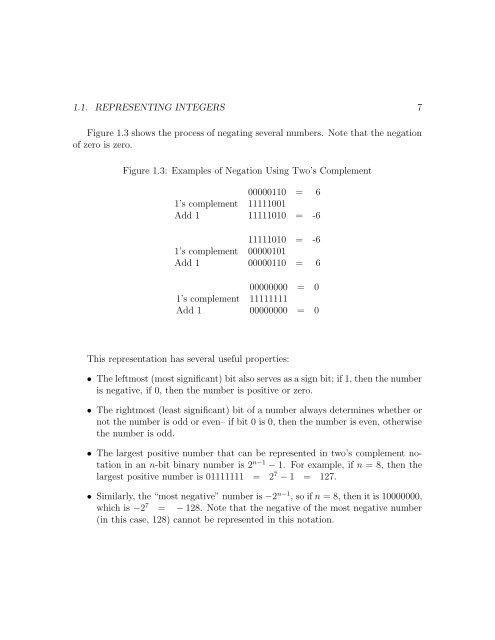MIPS Assembly Language Programming
MIPS Assembly Language Programming
MIPS Assembly Language Programming
Create successful ePaper yourself
Turn your PDF publications into a flip-book with our unique Google optimized e-Paper software.
1.1. REPRESENTING INTEGERS 7<br />
Figure 1.3 shows the process of negating several numbers. Note that the negation<br />
of zero is zero.<br />
Figure 1.3: Examples of Negation Using Two’s Complement<br />
00000110 = 6<br />
1’s complement 11111001<br />
Add 1 11111010 = -6<br />
11111010 = -6<br />
1’s complement 00000101<br />
Add 1 00000110 = 6<br />
00000000 = 0<br />
1’s complement 11111111<br />
Add 1 00000000 = 0<br />
This representation has several useful properties:<br />
• The leftmost (most significant) bit also serves as a sign bit; if 1, then the number<br />
is negative, if 0, then the number is positive or zero.<br />
• The rightmost (least significant) bit of a number always determines whether or<br />
not the number is odd or even– if bit 0 is 0, then the number is even, otherwise<br />
the number is odd.<br />
• The largest positive number that can be represented in two’s complement notation<br />
in an n-bit binary number is 2 n−1 − 1. For example, if n = 8, then the<br />
largest positive number is 01111111 = 2 7 − 1 = 127.<br />
• Similarly, the “most negative” number is −2 n−1 , so if n = 8, then it is 10000000,<br />
which is −2 7 = − 128. Note that the negative of the most negative number<br />
(in this case, 128) cannot be represented in this notation.

















